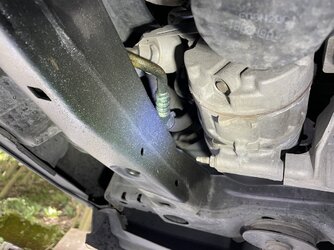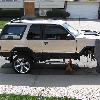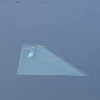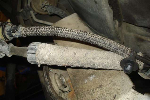libertystreet637
New Member
- Joined
- August 15, 2022
- Messages
- 4
- Reaction score
- 0
- City, State
- Victoria, TX
- Year, Model & Trim Level
- 2014 PIU
Pretty straightforward, there is clearly a leak on what I have determined is the ac discharge line. (I’ll include relevant photos, in case I’m clearly missing something obvious.)
Point aside, I do appliance repair and have my EPA Section 608 certification, so this seems like an accomplishable feat, there are just a few things I’m lost on.
I’ve got the workshop manual, but do not see quantities:
• Motorcraft® PAG Refrigerant Compressor Oil YN-12-D
• Motorcraft R-134a Refrigerant YN-19 (US).
I am still parsing through the manual for specifics, but as to the refrigerant, is the YN-19 the same as is the 12 oz cans? (I don’t necessarily think I’ll need 30 lbs of it …)
Basically when I drive the car around, I can smell what smells like burning rubber almost, no warning lights, no overt warning signs (other than the smell). The radiator hose was collapsed, but returned to normal size, and I haven’t inspected it enough, but it seems like the coolant bay rises when the car is on, so I’m not sure if there is also a blockage, but after some driving, the engine didn’t overheat or anything.
These issues cropped up after placing my car on a trailer on the back of a 26’ Penske, and driving from Texas to NJ. Pulled it off the trailer, and noticed the burning rubber smell as the car sat turned on while I used a 12v tire pump to check all 4 tires. Drove it maybe 15 miles, still smelled funky, then inspected and found the leaks you see in the photo.



Point aside, I do appliance repair and have my EPA Section 608 certification, so this seems like an accomplishable feat, there are just a few things I’m lost on.
I’ve got the workshop manual, but do not see quantities:
• Motorcraft® PAG Refrigerant Compressor Oil YN-12-D
• Motorcraft R-134a Refrigerant YN-19 (US).
I am still parsing through the manual for specifics, but as to the refrigerant, is the YN-19 the same as is the 12 oz cans? (I don’t necessarily think I’ll need 30 lbs of it …)
Basically when I drive the car around, I can smell what smells like burning rubber almost, no warning lights, no overt warning signs (other than the smell). The radiator hose was collapsed, but returned to normal size, and I haven’t inspected it enough, but it seems like the coolant bay rises when the car is on, so I’m not sure if there is also a blockage, but after some driving, the engine didn’t overheat or anything.
These issues cropped up after placing my car on a trailer on the back of a 26’ Penske, and driving from Texas to NJ. Pulled it off the trailer, and noticed the burning rubber smell as the car sat turned on while I used a 12v tire pump to check all 4 tires. Drove it maybe 15 miles, still smelled funky, then inspected and found the leaks you see in the photo.
















